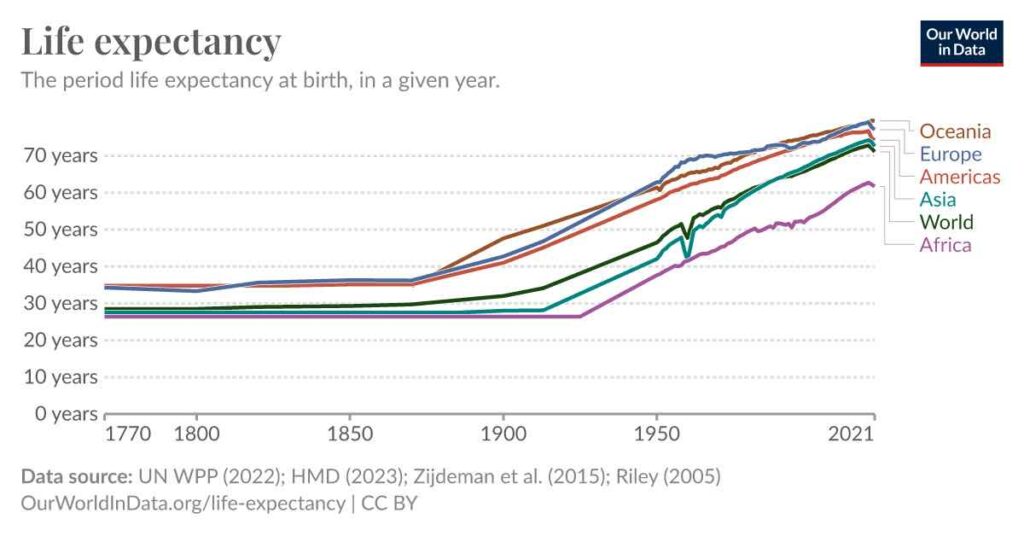Life expectancy is a hot topic in the growing market of longevity. A crucial part of achieving longevity, life expectancy is often overlooked for easier or sexier solutions such as supplements and fitness fads.
In this article we look at the common causes of death for most people, ways to use life expectancy trends to help guide your longevity protocols and much more.
Key Takeaways
- Life expectancy is an important measure of your potential lifespan and a population’s health and social progress.
- Significant events, such as the COVID-19 pandemic, can cause notable impacts on life expectancy trends.
- Statistically, you are more likely to die from common health problems and your longevity protocol should factor this into account
Historical Trends of Life Expectancy
Life expectancy has seen substantial changes throughout human history, particularly during the 20th and 21st centuries. The advancements in medicine, improvements in public health, and socio-economic developments have been instrumental in this shift.
20th and 21st Century Developments
The 20th century marked significant progress in public health that translated into increases in life expectancy. With the discovery of antibiotics, vaccination programs, and better standards of living, longevity experienced a notable surge. In the early 1900s, global life expectancy was estimated to be around 30-40 years, but by the end of the century, it had more than doubled.
During the 21st century, this trend continued, albeit at a slower pace. For example, in the United States, life expectancy at birth rose from 39.4 years in 1860 to 78.9 years in 2020. However, the increase in longevity was not evenly distributed across all populations, with disparities evident across different socioeconomic groups and geographic regions.
It’s essential to recognize that recent data has shown a decline in life expectancy in some developed countries, including the United States. Various factors have contributed to this decline, such as increased mortality rates among adults aged 25-64 years and escalating healthcare issues like obesity and opioid addiction. This downtrend serves as a sobering reminder of the complex interplay of factors that impact national life expectancy figures. Despite the general upward trajectory of longevity, specific challenges and health crises can lead to setbacks, as evidenced by the mortality rates during 2010-2017.
Determinants of Life Expectancy
Life expectancy is influenced by a complex interplay of factors ranging from genetics, habits to socio-economic determinants. This section explores how genetic and environmental contributors and the healthcare system impact longevity.
Genetic and Environmental Factors
Genetics play a crucial role in determining longevity, as certain inherited traits can predispose individuals to longer life spans or to particular diseases that might shorten life. For instance, a family history of longevity could suggest genetic resilience to age-related diseases. Environmental factors, such as exposure to pollutants or toxins, can also significantly affect life expectancy. Clean air and water, nutritious diets, and safe living conditions are essential for good health and extended longevity.
Healthcare Systems and Access
Accessible and efficient healthcare systems are key determinants of life expectancy. A healthcare system that provides universal coverage and quality care is instrumental in early disease detection, treatment, and management. Moreover, access to healthcare is a crucial factor, as it allows individuals from diverse socio-economic backgrounds to receive necessary medical interventions, which in turn can reduce inequalities in life expectancy.
Global Life Expectancy Statistics
Life expectancy has undergone significant changes worldwide with numbers varying greatly across different regions and between genders.
Current Global Averages
The global average life expectancy has seen an impressive increase over the past decades. According to Our World in Data, it stood at just over 70 years in 2021. However, the United Nations data projects the life expectancy for 2024 at approximately 73.33 years, indicating a continuous upward trend.

Life Expectancy In Different Geographies
There is a remarkable variation in life expectancy across different countries. For instance, Japan is known for its high life expectancy rates, while countries like Chad have a much lower figure. Factors contributing to these differences include healthcare quality, diet, lifestyle, and socio-economic conditions. Please see below for a comparison of life expectancy between selected countries:
- Hong Kong: Ranked high with a notable life expectancy at 85.24 in 2024
- Sweden: Known for a robust healthcare system contributing to higher life expectancy at 83.47 years
- Israel & France: Both countries exhibit above-average life expectancy figures at 83.63 and 83.49 respectively
- United States: While high, the life expectancy is lower than some other developed countries at 79.25 years
- Australia: At 84.06, Australians also rank highly in terms of life expectancy
Gender Discrepancies in Life Expectancy
Gender plays a significant role in determining life expectancy. Globally, women tend to live longer than men. This gender gap is evident in nearly all countries, with women outliving men by several years on average. The reasons for this discrepancy are complex and may involve biological, social, and health-related factors. For instance:
- Men in the United States typically have a lower life expectancy compared to women
- Across countries such as Japan, Sweden, and France, the trend of women living longer persists
Globally the average life expectancy of women is 76 years whilst men sit at 70.8.
Impact of Diseases and Conditions
Understanding the impact of diseases on life expectancy is crucial as it directly affects mortality rates and overall health in populations. It should also guide your daily decisions around habit formation, nutrition and other health factors as different diseases will have varying degrees of influence on life expectancy, from acute infections to chronic diseases and mental health conditions.
Infectious Diseases Impact
Infectious diseases can drastically alter death rates, particularly in the absence of effective treatments or vaccines. For example, COVID-19 caused significant global mortality, disrupting health systems and reducing life expectancy in many regions. It highlighted the critical need for rapid public health responses to manage such outbreaks.
Chronic Diseases Influence
Chronic conditions like heart disease and Alzheimer’s disease have a profound influence on life expectancy. Each additional chronic condition can reduce life expectancy, with heart disease being a leading cause of death. Moreover, individuals with multiple chronic conditions may experience a more significant decline in life expectancy, highlighting the importance of prevention and management.
Mental Health and Life Expectancy
Mental health conditions can also affect life expectancy. For instance, severe mental health disorders may increase the risk of suicide, which contributes to premature mortality. Furthermore, there is evidence to suggest that the sequence in which mental and physical health conditions are acquired can influence an individual’s life expectancy.
Sociodemographic Factors
Sociodemographic factors encompass a range of influences that contribute to variations in life expectancy, including economic conditions, educational attainment, and social class. These factors intertwine to shape health outcomes and longevity across different population groups.
Economic Factors
Economic stability and growth are fundamental determinants of life expectancy. Higher income levels and lower unemployment rates directly correlate with greater access to healthcare services and healthier living conditions, thereby potentially increasing life expectancy. Conversely, economies marked by poverty and high-income inequality tend to exhibit lower life expectancies. For instance, research shows that gross domestic product (GDP), income level, and other macroeconomic factors are significantly associated with life expectancy (A Systematic Review).
Educational Attainment and Literacy
Educational attainment and literacy levels are powerful predictors of life expectancy. The higher the education level, the more likely individuals are to engage in health-promoting behaviours and access healthcare services. Data shows that low literacy rates are often linked with higher infant mortality rates and shorter life expectancies. Conversely, improved education generally leads to better economic status and healthier lifestyles, thus extending life expectancy (Social Inequality and the Future of U.S. Life Expectancy).
Social Class and Lifestyle
Social class, encapsulating factors like occupation, income, and social status, significantly influences life expectancy. Individuals from higher social classes tend to have better access to healthcare and are more likely to adopt healthy lifestyles, contributing to longer life expectancies. Lifestyle choices, such as diet, physical activity, and tobacco and alcohol use, are also shaped by sociodemographic factors and have a significant effect on longevity. Certain demographic groups face declines in life expectancy, highlighting the impact of social class on health outcomes (Recent research also documents significant declines).
Related Posts:
Top 10 Causes Of Death
Understanding the primary causes of mortality is crucial for improving public health strategies and increasing life expectancy. Lifestyle choices and chronic diseases are at the forefront of these factors.
The CDC states the top 10 causes of death in 2021 in the US were:
- Heart disease: 695,547
- Cancer: 605,213
- COVID-19: 416,893
- Accidents (unintentional injuries): 224,935
- Stroke (cerebrovascular diseases): 162,890
- Chronic lower respiratory diseases: 142,342
- Alzheimer’s disease: 119,399
- Diabetes: 103,294
- Chronic liver disease and cirrhosis : 56,585
- Nephritis, nephrotic syndrome, and nephrosis: 54,358
As you can see a lot of the common causes of death can be linked to lifestyle-related diseases.
The Correlation Between Life Expectancy and Lifestyle Factors
Lifestyle choices such as diet, physical activity, and tobacco use have a profound impact on an individual’s risk for developing health conditions like cardiovascular disease and obesity. These conditions significantly shorten life expectancy by increasing the risk of serious complications. A balanced diet and regular exercise can mitigate these risks, leading to a decrease in the prevalence of life-threatening health issues.
Biggest Health Concerns In The 21st Century
In recent decades, there has been a shift in the leading causes of death, with lifestyle-related and non-communicable diseases dominating. Some of the biggest health concerns now include cardiovascular disease, cancers, respiratory diseases, and diabetes. These conditions often stem from obesity and poor diet, illustrating the importance of health education and preventive measures in prolonging life.
These health issues, which represent the top causes of death globally, challenge healthcare systems and policymakers to adapt and respond to the changing health landscape. Addressing these concerns with effective interventions can contribute to improving life expectancy.
The Blue Zones Of Longevity
Blue Zones are remarkable regions where people enjoy exceptionally long lifespans. The study of these areas reveals critical lifestyle and environmental factors contributing to longevity.

Common Factors That Increase Life Expectancy
Diet: A cornerstone of Blue Zone inhabitants’ longevity is their plant-based diet. Staples include beans, grains, leafy greens, and nuts, with meat consumed sparingly. The citizens of these zones consume a variety of fruits and vegetables, which are high in nutrients and fiber, promoting better health and longevity.
Physical Activity: Incorporating natural movement throughout the day is integral. Residents of Blue Zones don’t necessarily engage in structured exercise routines; instead, their environment encourages constant moderate physical activity, such as gardening or walking.
Social Engagement: Strong family ties and active social life are prominent in these regions. Regularly connecting with others in meaningful ways seems to play a significant role in their increased life expectancy.
Stress Reduction: People living in Blue Zones have routines to shed stress. Whether through napping, meditation, or socializing, managing stress leads to less chronic inflammation and healthier, longer lives.
Moderate Caloric Intake: There is a tendency among these communities to eat until they are 80% full. This practice, known as ‘Hara Hachi Bu’, may contribute to lower average caloric intake and less likelihood of obesity.
Low Smoking Rates: Smoking is rare in Blue Zones, which corresponds to lower incidences of lung and other cancers, as well as heart disease.
Engaging in these behaviors, observed across various populations within the Blue Zones, points to a synergistic effect on well-being and life span. They provide valuable insights into the attainable practices that can help improve longevity and quality of life.
Related Posts:
- Sleep: The Importance of Quality Rest for Optimal Health
- Nutrition: Simple Principles To Avoid The YoYo Diet
- Andrew Huberman Routine & Supplements: Unveiling His Daily Success Formula
- Peter Attia Supplements & Daily Routine: Insights into a Longevity Expert’s Regimen
- Bryan Johnson Blueprint: Daily Routine, Supplements & Protocol
- Best Longevity Supplements: Top Picks for Life Extension
- Outlive Review: Unveiling the Longevity Secrets of the Healthiest Populations
Future Projections and Challenges
Advancements in medical technology and healthcare are shaping projections for life expectancy. The average life expectancy is anticipated to encounter a progressive rise, given the rapid innovation in medical treatments and preventative care. The World Economic Forum forecasts a significant increase in the population living to 100 and beyond by 2050.
Frequently Asked Questions
Do men or women live longer?
Statistically, women tend to live longer than men. In the United States, the average life expectancy is about 81 years for women and 76 years for men.
What factors contribute to differences in life expectancy across countries?
Differences in life expectancy across countries can be attributed to several factors including healthcare access, socioeconomic status, diet, lifestyle, and public health policies.
How can an individual’s life expectancy be calculated?
Individual life expectancy can be estimated using actuarial life tables, which consider factors such as age, gender, health status, and sometimes lifestyle choices or geographic location.
What is the average life expectancy in Australia?
In Australia, long-term survival rates indicate that the life expectancy has been increasing, with recent data suggesting averages of up to 82.5 years.
What is the average difference in life expectancy in the United States?
The average life expectancy in the United States is close to 79 years; however, there’s an approximate 5-year difference between the life expectancies of women and men.
At what age is life expectancy considered from a statistical point of view?
Life expectancy is typically considered from birth from a statistical perspective; however, it can also be calculated from any given age.
How does life expectancy change with a person’s current age?
As a person ages, their individual life expectancy changes due to decreasing immediate risk of death. This means that the longer a person lives, the higher their life expectancy may become at each subsequent age.
What statistical methods are used to estimate the probability of living to an advanced age, such as 90 years old?
Statisticians use survival analysis and actuarial life tables to estimate the probability of living to an advanced age, taking into account mortality rates at each stage of life.
